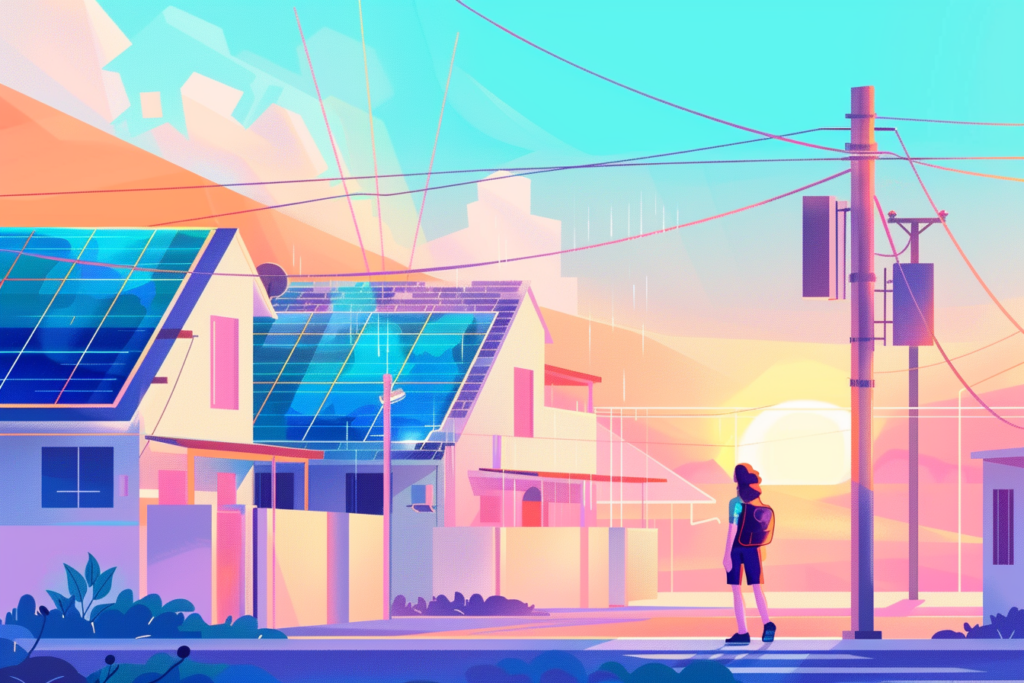The push towards renewable energy has intensified in recent years, with solar power leading the charge. Due to various reasons, unfortunately, not everyone can install solar panels.
Reasons that prevent installation can include anything from lack of space, unsuitable roof conditions, or the initial high costs associated with solar panel installation. This is where community solar comes into play, offering a collaborative approach to harnessing solar energy.
Let’s dive into what community solar is, its benefits, and how it’s shaping the future of renewable energy consumption.
Understanding Community Solar
Community solar is what is sounds lke, it’s when a solar power plant electricity is shared by more than one household. Its primary aim is to allow community members to share the core benefits of solar power even if they are unable or prefer not to install solar panels on their property.
Typically, community solar projects involve a large-scale solar array located offsite. Participants can subscribe to or purchase a share of the solar array, and in return, they receive an electricity bill credit for their share of the power produced.
The Benefits of Community Solar
Community solar offers several benefits, but below are some of the core advantages.
Accessibility
Community solar panels open the door to renewable energy for those who live in apartments, have shaded roofs, or own homes unsuitable for solar panel installation. It democratizes access to solar energy, ensuring that more people can contribute to and benefit from renewable energy initiatives.
Cost Savings
Participants can save on their electricity bills without the significant upfront investment required for personal solar installations. Community solar projects often offer fixed electricity rates that are lower than traditional utility rates, providing long-term savings.
Environmental Impact
By supporting community solar, participants contribute to reducing greenhouse gas emissions collectively as well as being dependent on fossil fuels, leading to a cleaner, more sustainable energy future.
Economic Benefits
Community solar projects create jobs and stimulate the local economy. They often involve local contractors and service providers, keeping the economic benefits within the community.
Scalability
These projects can be scaled to match the community’s size and energy needs, making solar energy more efficient and reducing wastage.
Related: Top 9 Reasons To Switch To Solar Today
How Community Solar Works

Community solar projects can operate under various business models, but most follow a subscription-based or ownership model.
- Subscription Model: Participants pay a monthly fee to lease a portion of the community solar array. They then receive credits on their electricity bill based on their personal solar energy produced from their home.
- Ownership Model: Participants purchase a portion of the solar array. They own the solar panels or share them outright and receive credits for energy that reduce their monthly electricity bills.
The generated power is fed into the local power grid regardless of the model. The utility company then credits subscribers for their share of the solar energy produced, reducing their monthly electricity costs.
Participating in Community Solar
Participation in a community solar project typically involves signing up through a solar provider that manages the community solar array. Here’s how to get started:
Research Providers
Look for community solar providers in your area and compare their offers, including the cost, contract terms, and estimated savings.
Understand the Terms
Carefully review the contract to understand your commitment, how billing and credits work, and the process for transferring or canceling your subscription.
Subscribe or Purchase
Once you’ve selected a provider, you can subscribe to or purchase your share of the community solar project. There’s usually no need for equipment installation on your property.
Challenges and Considerations
While community solar has numerous benefits, there are challenges to consider. Availability is limited in some areas, depending on local regulations and the development of solar projects.
Furthermore, the financial benefits can vary based on the project’s location, the utility’s policies, and the specifics of the contract. It’s essential to conduct thorough research and possibly consult with an energy advisor to ensure that joining a community solar project aligns with your energy needs and financial goals.
The Future of Community Solar
As the demand for renewable energy sources continues to grow, community solar stands out as a viable solution to increase solar energy adoption. It supports environmental sustainability and promotes social equity by making solar accessible to more people.
With ongoing advancements in solar technology and government-supportive policies, the future of community solar looks bright, promising a more inclusive and sustainable energy landscape.
Conclusion
Community solar represents a significant step forward toward a more sustainable and equitable energy future for everyone. Allowing individuals to share in the benefits of solar power without the need for personal installations opens up new pathways for adopting renewable energy.
Whether you’re motivated by the environmental benefits, cost savings, or both, community solar offers a practical and impactful way to contribute to the global shift toward green energy. As this movement grows, it has the potential to reshape our energy systems and strengthen community ties through shared commitments to sustainability and innovation.
You might also be interested in: 7 Solar Energy Myths Debunked




